Quantifying Rainfall Interception Loss of a Subtropical Broadleaved Forest in Central Taiwan
Abstract
:1. Introduction
2. Experimental Setup
2.1. Site Description
2.2. Instrumental Setup and Data Collection
| Event | Period (min) | (mm) | (mm) | (mm) | I (mm) | () | (%) | (mm) | p (%) | (mm) | (%) | () | () |
|---|---|---|---|---|---|---|---|---|---|---|---|---|---|
| 1 | 120 | 1.5 | 0.72 | 0.00 | 0.78 | 0.75 | – | – | – | – | – | – | – |
| 2 | 600 | 16.1 | 11.43 | 0.30 | 4.37 | 1.61 | 22.90 | 5.39 | 47.50 | 2.13 | 1.86 | 0.37 | 0.47 |
| 3 | 420 | 69.9 | 54.82 | 8.81 | 6.27 | 9.99 | 9.20 | 5.62 | 61.30 | 0.87 | 12.60 | 0.92 | 0.15 |
| 4 | 120 | 5.2 | 4.06 | 0.09 | 1.05 | 2.60 | – | – | – | – | – | – | – |
| 5 | 420 | 12.0 | 10.11 | 0.23 | 1.66 | 1.71 | 7.19 | 5.96 | 65.20 | 1.51 | 1.92 | 0.12 | 0.12 |
| 6 | 180 | 7.7 | 5.84 | 0.20 | 1.66 | 2.57 | – | – | – | – | – | – | – |
| 7 | 180 | 29.5 | 23.11 | 1.63 | 4.76 | 9.83 | 8.01 | 5.72 | 47.20 | 2.41 | 5.53 | 0.79 | NA |
| 8 | 300 | 19.5 | 14.18 | 1.19 | 4.13 | 3.90 | 16.00 | 3.35 | 41.20 | 1.52 | 6.10 | 0.62 | 0.13 |
| 9 | 60 | 0.2 | 0.00 | 0.00 | 0.20 | 0.20 | – | – | – | – | – | – | – |
| 10 | 60 | 1.7 | 0.63 | 0.00 | 1.07 | 1.70 | – | – | – | – | – | – | – |
| 11 | 120 | 0.9 | 0.59 | 0.00 | 0.31 | 0.45 | – | – | – | – | – | – | – |
| 12 | 480 | 92.4 | 74.78 | 13.22 | 4.40 | 11.55 | 3.70 | 5.40 | 58.40 | 1.19 | 14.31 | 0.43 | 0.20 |
| 13 | 240 | 37.3 | 29.97 | 3.38 | 3.95 | 9.33 | 0.20 | 6.79 | 32.20 | 4.33 | 9.06 | 0.02 | 0.23 |
| 14 | 240 | 8.7 | 6.43 | 0.09 | 2.18 | 2.18 | 7.98 | 5.10 | 55.50 | 1.79 | 1.03 | 0.83 | 0.18 |
| 15 | 360 | 42.1 | 31.37 | 7.01 | 3.72 | 7.02 | 9.30 | 3.47 | 37.70 | 1.49 | 16.65 | 0.64 | 0.10 |
| 16 | 120 | 3.3 | 2.12 | 0.02 | 1.16 | 1.65 | – | – | – | – | – | – | – |
| 17 | 60 | 0.2 | 0.00 | 0.00 | 0.20 | 0.20 | – | – | – | – | – | – | – |
| 18 | 240 | 20.1 | 13.72 | 3.13 | 3.25 | 5.03 | 9.48 | 6.24 | 49.20 | 1.55 | 15.57 | 0.48 | 0.21 |
| 19 | 240 | 49.1 | 34.16 | 11.43 | 3.51 | 12.28 | 2.90 | 5.07 | 38.20 | 1.97 | 23.28 | 0.36 | 0.16 |
| 20 | 60 | 2.1 | 0.97 | 0.02 | 1.71 | 2.70 | – | – | – | – | – | – | – |
| 21 | 180 | 44.0 | 30.18 | 11.19 | 2.63 | 14.67 | 1.50 | 5.97 | 31.10 | 2.55 | 25.43 | 0.22 | 0.28 |
| 22 | 60 | 2.1 | 0.97 | 0.01 | 1.12 | 2.10 | – | – | – | – | – | – | – |
| 23 | 360 | 22.6 | 17.06 | 2.79 | 2.75 | 3.77 | 7.00 | 8.72 | 52.40 | 2.46 | 12.35 | 0.26 | 0.16 |
| 24 | 60 | 1.3 | 1.06 | 0.00 | 0.24 | 1.30 | – | – | – | – | – | – | – |
| 25 | 180 | 14.5 | 13.12 | 0.26 | 1.12 | 4.83 | 1.70 | 3.51 | 68.50 | 0.99 | 1.79 | 0.08 | 0.12 |
| 26 | 120 | 4.7 | 3.22 | 0.03 | 1.45 | 2.35 | – | – | – | – | – | – | – |
| 27 | 300 | 37.4 | 31.16 | 3.58 | 2.66 | 7.48 | 6.60 | 6.26 | 64.80 | 1.20 | 9.57 | 0.49 | 0.08 |
| 28 | 120 | 22.0 | 16.02 | 3.20 | 2.78 | 11.00 | 8.00 | 4.04 | 56.60 | 0.93 | 14.55 | 0.88 | 0.16 |
| 29 | 480 | 15.8 | 11.64 | 1.90 | 2.26 | 1.98 | 9.19 | 3.17 | 60.50 | 0.60 | 12.03 | 0.18 | 0.12 |
| 30 | 240 | 9.5 | 8.24 | 0.22 | 1.04 | 2.38 | 7.31 | 1.67 | 66.40 | 0.41 | 2.32 | 0.17 | 0.11 |
| 31 | 60 | 2.1 | 1.23 | 0.00 | 0.87 | 2.10 | – | – | – | – | – | – | – |
| 32 | 1560 | 87.4 | 68.75 | 7.69 | 10.96 | 3.36 | 13.10 | 8.96 | 66.80 | 1.04 | 8.80 | 0.44 | 0.08 |
| 33 | 480 | 8.5 | 6.94 | 0.03 | 1.53 | 1.06 | 13.11 | 5.44 | 75.70 | 0.53 | 0.35 | 0.14 | 0.04 |
| 34 | 360 | 10.0 | 8.59 | 0.07 | 1.34 | 1.34 | 2.91 | 5.47 | 74.30 | 1.54 | 0.70 | 0.04 | 0.06 |
| 35 | 360 | 15.7 | 3.50 | 0.12 | 2.08 | 2.62 | 7.52 | 4.72 | 66.00 | 1.37 | 0.76 | 0.20 | NA |
| 36 | 300 | 7.6 | 5.59 | 0.01 | 2.00 | 1.52 | 23.49 | 4.16 | 68.10 | 0.34 | 0.13 | 0.36 | NA |
| 37 | 420 | 50.8 | 40.70 | 4.93 | 5.17 | 5.55 | 10.20 | 3.69 | 58.20 | 0.97 | 9.70 | 0.57 | NA |
| 38 | 60 | 1.4 | 0.63 | 0.00 | 0.77 | 1.40 | – | – | – | – | – | – | – |
| 39 | 180 | 3.0 | 1.90 | 0.00 | 1.10 | 1.00 | – | – | – | – | – | – | – |
| 40 | 120 | 0.6 | 0.28 | 0.00 | 0.32 | 0.30 | – | – | – | – | – | – | – |
| 41 | 120 | 4.1 | 3.43 | 0.02 | 0.65 | 2.05 | – | – | – | – | – | – | – |
| 42 | 720 | 76.0 | 62.11 | 7.31 | 6.58 | 6.33 | 7.50 | 4.02 | 52.7 | 1.22 | 9.54 | 0.48 | NA |
| 43 | 540 | 57.0 | 45.34 | 7.36 | 4.30 | 7.05 | 6.70 | 5.63 | 61.0 | 1.08 | 12.80 | 0.47 | NA |
| Total | Wet | 546.1 | 415.78 | 68.61 | 62.31 | – | – | – | – | – | – | – | – |
| Dry | 371.5 | 294.89 | 32.86 | 43.75 | – | – | – | – | – | – | – | – | |
| % to | Wet | 100.0 | 76.14 | 12.56 | 11.41 | Ave. | 7.58 | 5.50 | 50.03 | 1.86 | 10.47 | 0.44 | 0.19 |
| Dry | 100.0 | 79.69 | 8.85 | 11.78 | – | 9.91 | 4.63 | 64.21 | 0.91 | 6.52 | 0.36 | 0.10 |
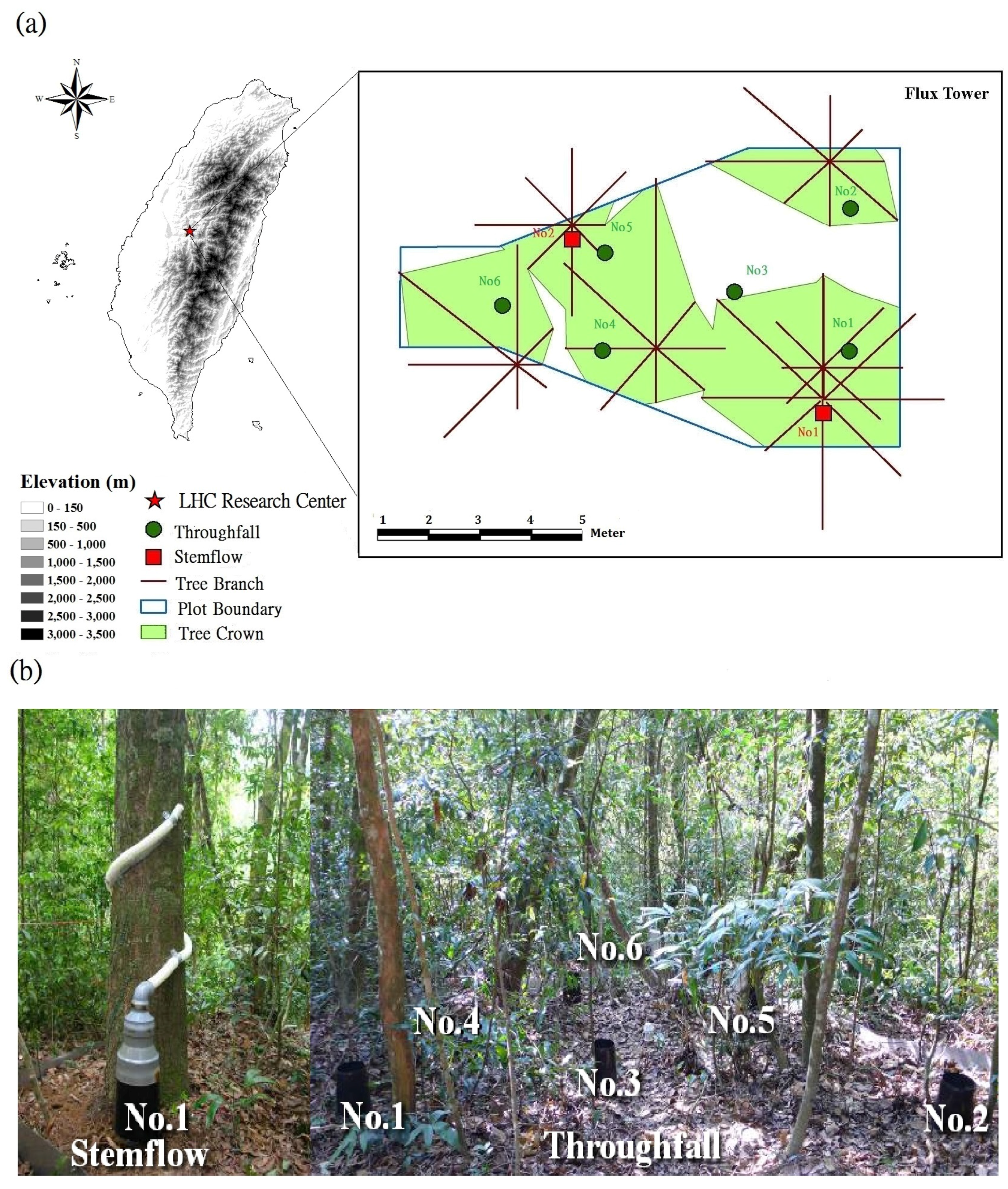
3. Methods
3.1. Gash Interception Model
3.2. Wet Canopy Evaporation
3.3. Analysis Procedure for Selecting Rainfall Events

4. Results
4.1. Canopy Water Balance and Interception

4.2. Wet Canopy Evaporation
4.3. Single Event Analysis
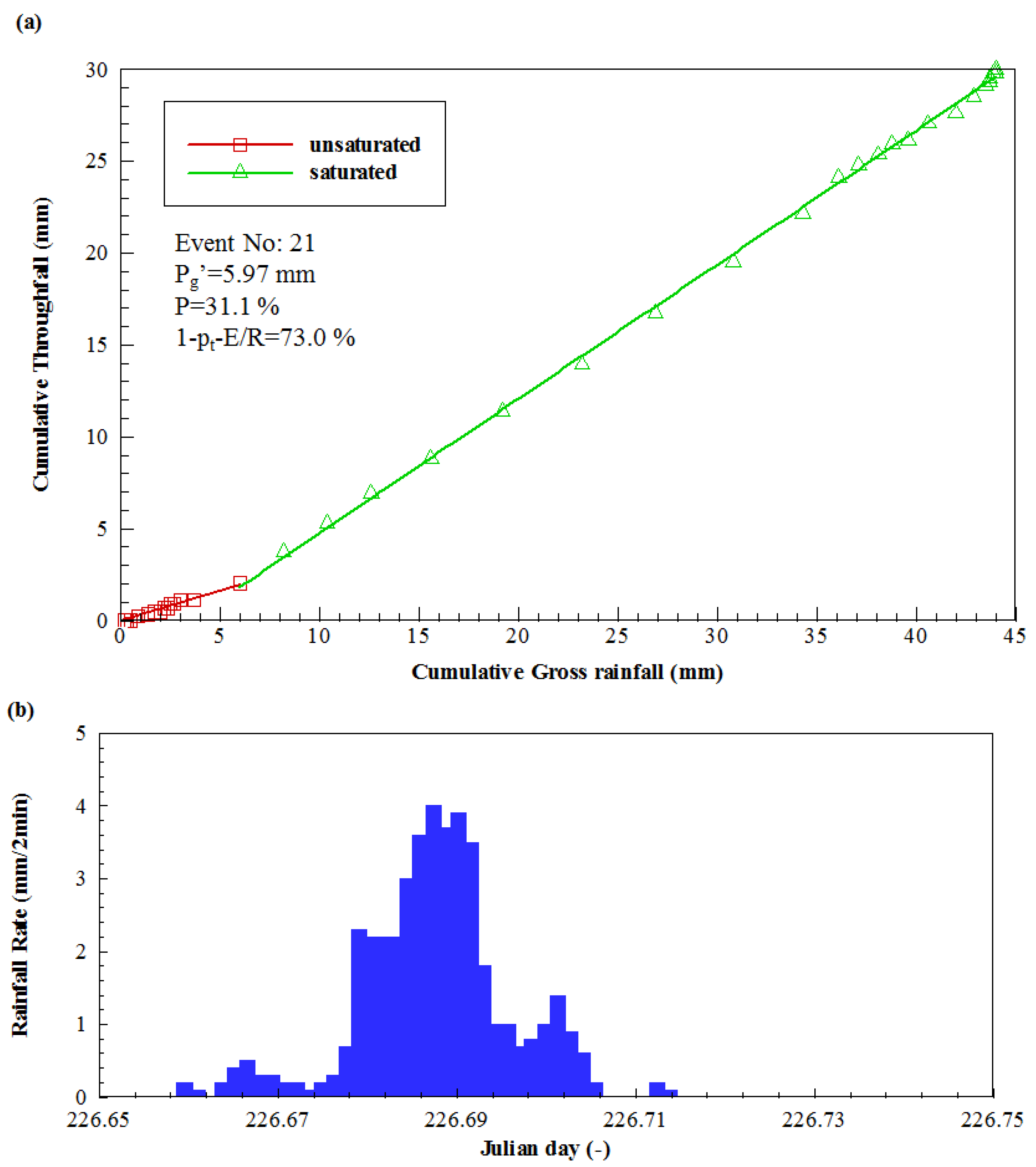
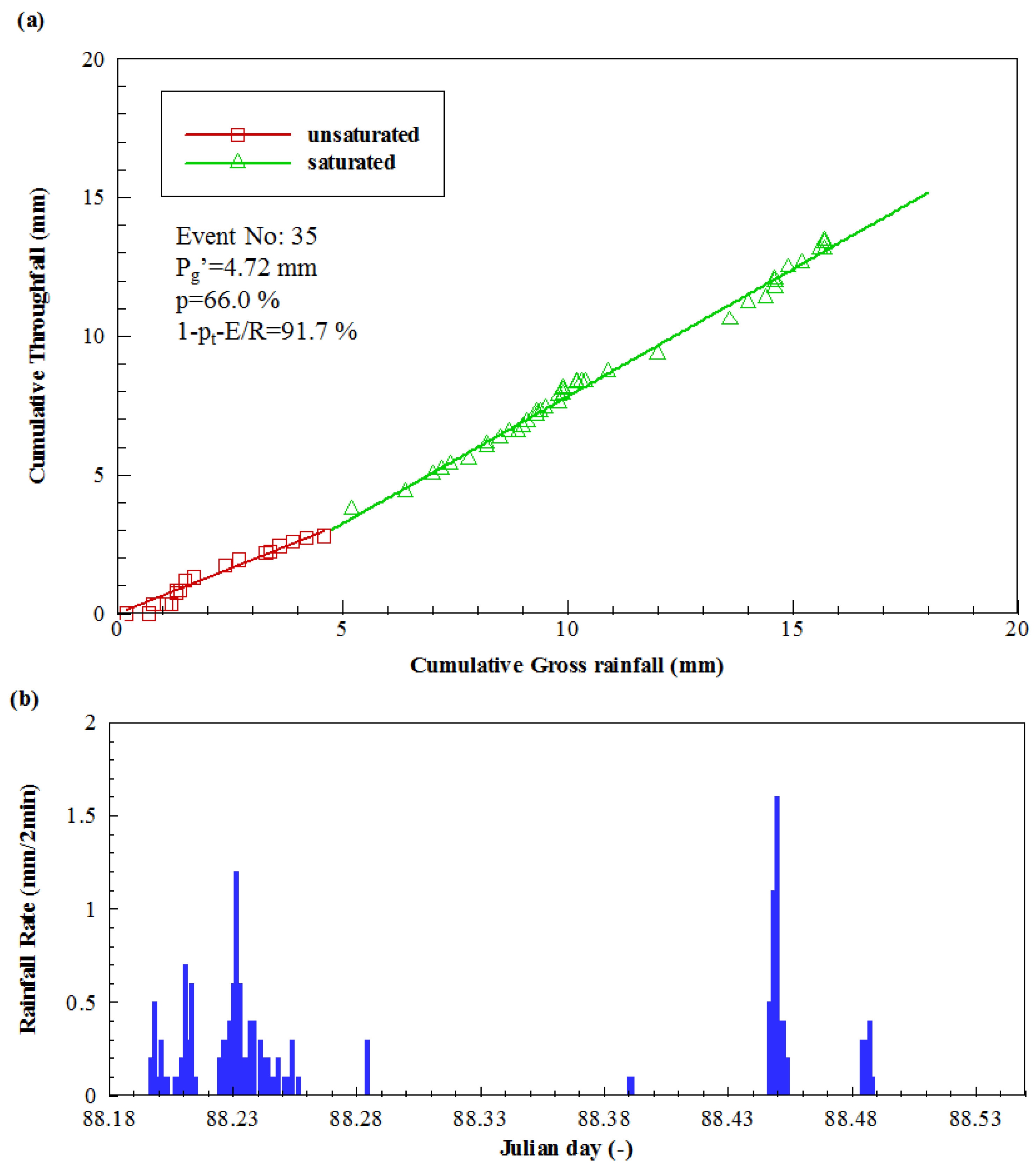
4.4. Multiple Event Analysis and Model Parametrisation
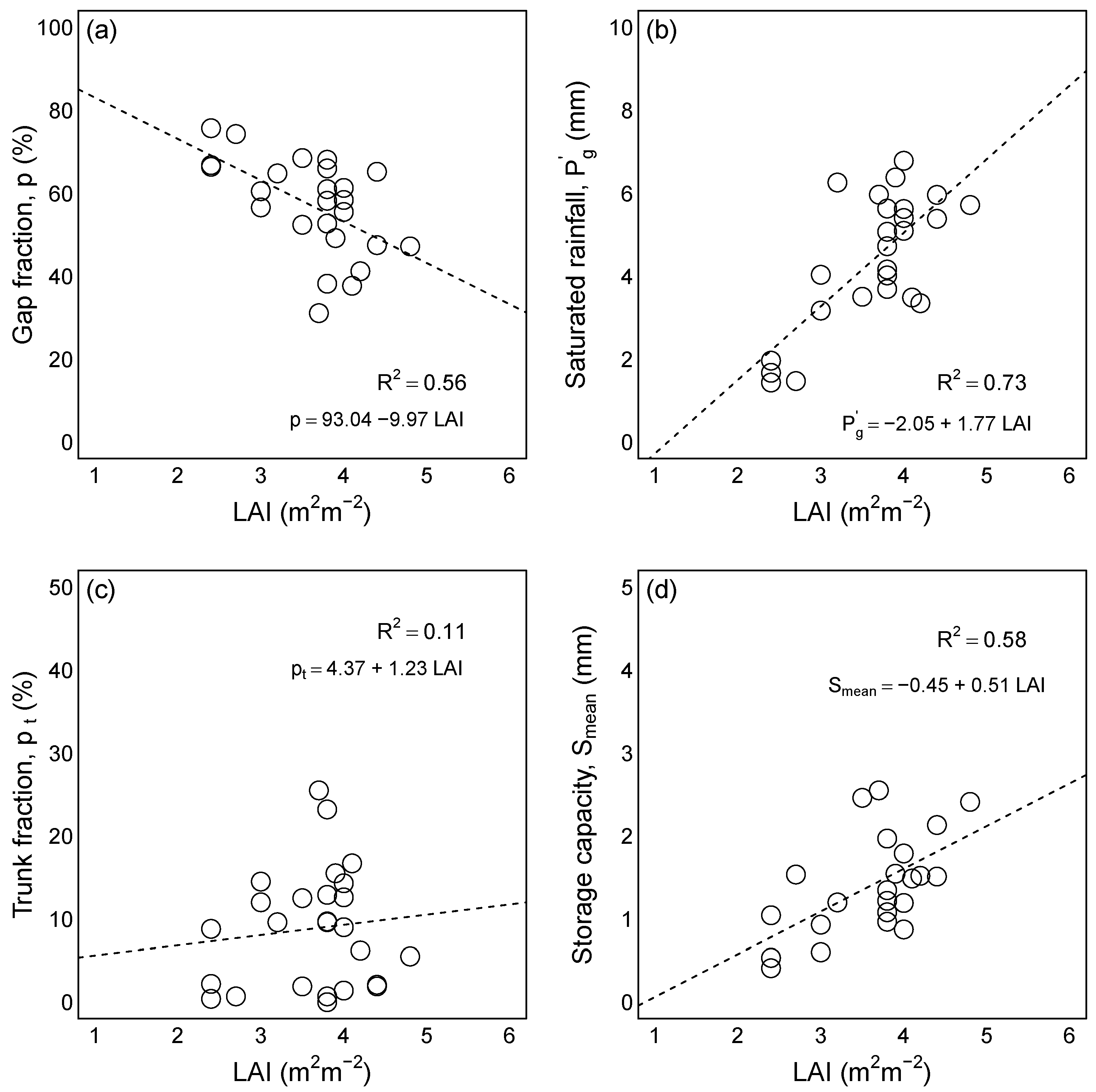
4.5. Model Error Assessment and Sensitivity Analysis
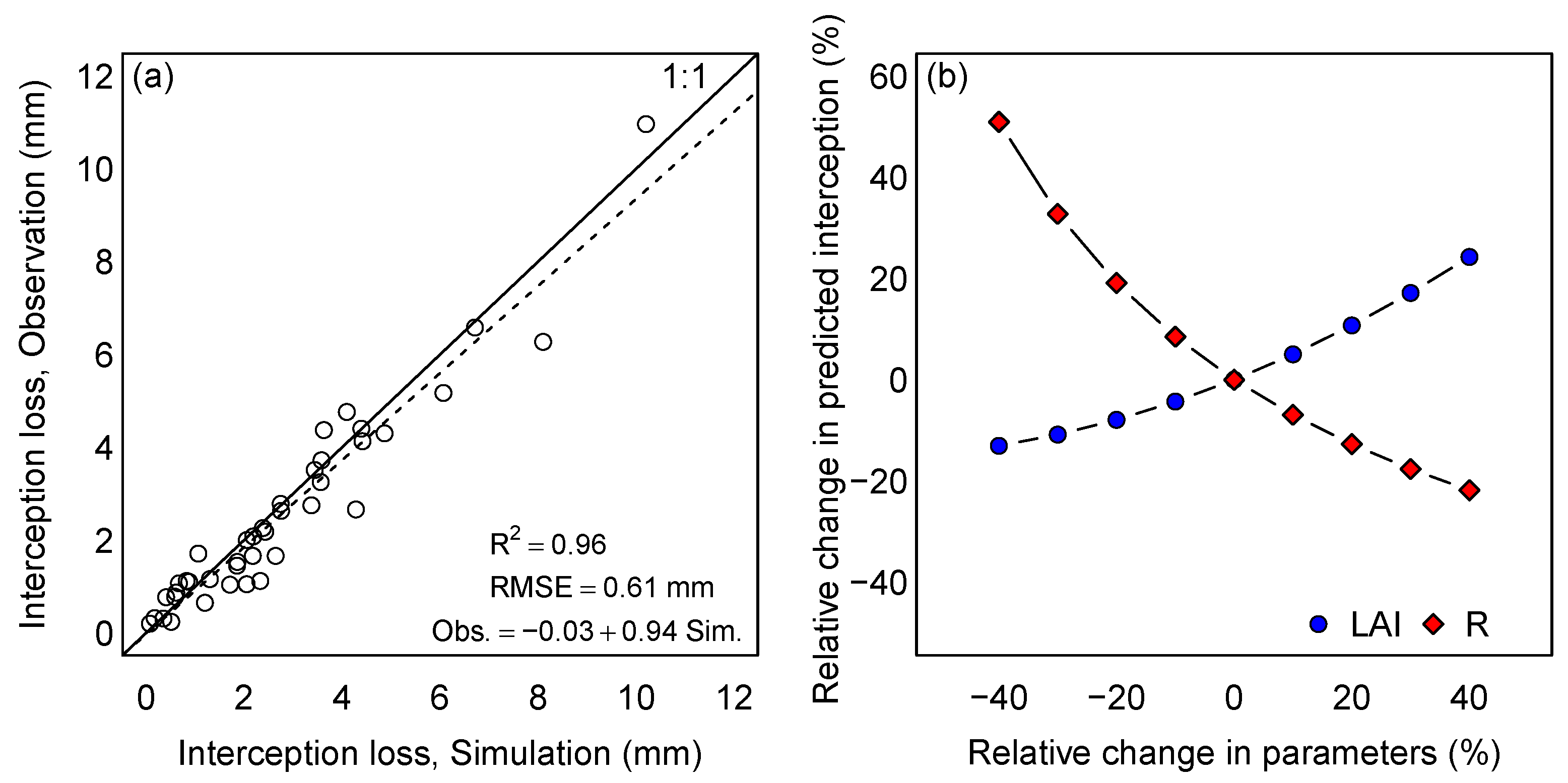
5. Discussion
5.1. Canopy Structure Parameters
5.2. Throughfall and Stemflow Yield
5.3. Wet Canopy Evaporation Rate
5.4. Rainfall Interception Loss

6. Conclusions
Acknowledgments
Author Contributions
Conflicts of Interest
Appendix A
A. Derivation of Equation (1)
References
- Link, T.E.; Unsworth, M.; Marks, D. The dynamics of rainfall interception by a seasonal temperate rainforest. Agric. For. Meteorol. 2004, 124, 171–191. [Google Scholar] [CrossRef]
- Pypker, T.G.; Bond, B.J.; Link, T.E.; Marks, D.; Unsworth, M.H. The importance of canopy structure in controlling the interception loss of rainfall: Examples from a young and an old-growth Douglas-fir forest. Agric. For. Meteorol. 2005, 130, 113–129. [Google Scholar] [CrossRef]
- Muzylo, A.; Llorens, P.; Valente, F.; Keizer, J.; Domingo, F.; Gash, J. A review of rainfall interception modelling. J. Hydrol. 2009, 370, 191–206. [Google Scholar] [CrossRef]
- Domingo, F.; Sánchez, G.; Moro, M.J.; Brenner, A.J.; Puigdefábregas, J. Measurement and modelling of rainfall interception by three semi-arid canopies. Agric. For. Meteorol. 1998, 91, 275–292. [Google Scholar] [CrossRef]
- Toba, T.; Ohta, T. An observational study of the factors that influence interception loss in boreal and temperate forests. J. Hydrol. 2005, 313, 208–220. [Google Scholar] [CrossRef]
- Zhang, Y.F.; Wang, X.P.; Hu, R.; Pan, Y.X.; Paradeloc, M. Rainfall partitioning into throughfall, stemflow and interception loss by two xerophytic shrubs within a rain-fed re-vegetated desert ecosystem, northwestern China. J. Hydrol. 2015, 527, 1084–1095. [Google Scholar] [CrossRef]
- Deguchi, A.; Hattori, S.; Park, H.T. The influence of seasonal changes in canopy structure on interception loss: Application of the revised Gash model. J. Hydrol. 2006, 318, 80–102. [Google Scholar] [CrossRef]
- Klaassen, W.; Bosveld, F.; de Water, E. Water storage and evaporation as constituents of rainfall interception. J. Hydrol. 1998, 212–213, 36–50. [Google Scholar] [CrossRef]
- Aboal, J.R.; Morales, D.; Hernández, M.; Jiménez, M.S. The measurement and modelling of the variation of stemflow in a laurel forest in Tenerife, Canary Islands. J. Hydrol. 1999, 221, 161–175. [Google Scholar] [CrossRef]
- Fleischbein, K.; Wilcke, W.; Goller, R.; Boy, J.; Valarezo, C.; Zech, W.; Knoblich, K. Rainfall interception in a lower montane forest in Ecuador: Effects of canopy properties. Hydrol. Process. 2005, 19, 1355–1371. [Google Scholar] [CrossRef]
- Loustau, D.; Berbigier, P.; Granier, A. Interception loss, throughfall and stemflow in a maritime pine stand. II. An application of Gash’s analytical model of interception. J. Hydrol. 1992, 138, 469–485. [Google Scholar] [CrossRef]
- Iida, S.; Tanaka, T.; Sugita, M. Change of evapotranspiration components due to the succession from Japanese red pine to evergreen oak. J. Hydrol. 2006, 326, 166–180. [Google Scholar] [CrossRef]
- Herbst, M.; Rosier, P.T.W.; McNeil, D.D.; Harding, R.J.; Gowing, D.J. Seasonal variability of interception evaporation from the canopy of a mixed deciduous forest. Agric. For. Meteorol. 2008, 148, 1655–1667. [Google Scholar] [CrossRef]
- Lu, S.; Tang, K. Study on Rainfall Interception Characteristics of Natural Hardwood Forest in Central Taiwan; Bulletin of Taiwan Forestry Research Institute; Taiwan Forestry Research Institute: Taipei, Taiwan, 1995; Volume 10, pp. 447–457. [Google Scholar]
- Lin, T.C.; Hsia, Y.J.; King, H. A study on rainfall interception of a natural hardwood forest in northeastern Taiwan. Taiwan J. For. Sci. 1996, 11, 393–400. [Google Scholar]
- Lu, S.Y.; Cheng, J.D.; Brooks, K.N. Managing forests for watershed protection in Taiwan. For. Ecol. Manag. 2001, 143, 77–85. [Google Scholar] [CrossRef]
- Chiang, P.N.; Zhuang, S.Y.; Wang, Y.N.; Wang, W.; Wang, M.K.; Lin, S.T. Soil Organic Matter and Soil Physicochemical Properties Associated with Forest Fires in Central Taiwan. Soil Sci. 2008, 173, 768–778. [Google Scholar] [CrossRef]
- Lin, T.C.; Hamburg, S.P.; Lin, K.C.; Wang, L.J.; Chang, C.T.; Hsia, Y.J.; Vadeboncoeur, M.A.; Mabry McMullen, C.M.; Liu, C.P. Typhoon Disturbance and Forest Dynamics: Lessons from a Northwest Pacific Subtropical Forest. Ecosystems 2011, 14, 127–143. [Google Scholar] [CrossRef]
- Lugo, A.E. Visible and invisible effects of hurricanes on forest ecosystems: An international review. Austral Ecol. 2008, 33, 368–398. [Google Scholar] [CrossRef]
- Lin, K.C.; Hamburg, S.P.; Tang, S.L.; Hsia, Y.J.; Lin, T.C. Typhoon effects on litterfall in a subtropical forest. Can. J. For. Res. 2003, 33, 2184–2192. [Google Scholar] [CrossRef]
- Chi, C.H.; McEwan, R.W.; Chang, C.T.; Zheng, C.; Yang, Z.; Chiang, J.M.; Lin, T.C. Typhoon Disturbance Mediates Elevational Patterns of Forest Structure, but not Species Diversity, in Humid Monsoon Asia. Ecosystems 2015, 18, 1410–1423. [Google Scholar] [CrossRef]
- Dingman, S. Physical Hydrology, 2nd ed.; Prentice Hall: Upper Saddle River, NJ, USA, 2002. [Google Scholar]
- Gash, J.H.C. An analytical model of rainfall interception by forests. Q. J. R. Meteorol. Soc. 1979, 105, 43–55. [Google Scholar] [CrossRef]
- Horng, F.W.; Hsia, Y.J.; Tang, K.J. An Estimation of Aboveground Biomass and Leaf Area in a Secondary Warm Temperate Montane Rain Forest at Lien-Hua-Chi Area; Taiwan Forestry Research Institute: Taipei, Taiwan, 1986. [Google Scholar]
- McEwan, R.W.; Lin, Y.C.; Sun, I.F.; Hsieh, C.F.; Su, S.H.; Chang, L.W.; Song, G.Z.M.; Wang, H.H.; Hwong, J.L.; Lin, K.C.; et al. Topographic and biotic regulation of aboveground carbon storage in subtropical broad-leaved forests of Taiwan. For. Ecol. Manag. 2011, 262, 1817–1825. [Google Scholar] [CrossRef]
- Chen, C.S.; Chen, Y.L. The Rainfall Characteristics of Taiwan. Mon. Weather Rev. 2003, 131, 1323–1341. [Google Scholar] [CrossRef]
- Hwong, J.L. Studies on the Characteristics of Hydrology and Water Chemistry between Natural Hardwood and China-Fir Plantation Forests in Lienhuachih Experimental Watersheds. Ph.D. Thesis, National Taiwan University, Taipei, Taiwan, 2010. [Google Scholar]
- Chen, Y.Y.; Chu, C.R.; Li, M.H. A gap-filling model for eddy covariance latent heat flux: Estimating evapotranspiration of a subtropical seasonal evergreen broad-leaved forest as an example. J. Hydrol. 2012, 468–469, 101–110. [Google Scholar] [CrossRef]
- Ziegler, A.D.; Giambelluca, T.W.; Nullet, M.A.; Sutherland, R.A.; Tantasarin, C.; Vogler, J.B.; Negishi, J.N. Throughfall in an evergreen-dominated forest stand in northern Thailand: Comparison of mobile and stationary methods. Agric. For. Meteorol. 2009, 149, 373–384. [Google Scholar] [CrossRef]
- Chen, Y.Y.; Li, M.H. Determining adequate averaging periods and reference coordinates for eddy covariance measurements of surface heat and water vapor fluxes over mountainous terrain. Terr. Atmos. Ocean. Sci. 2012, 23, 685–701. [Google Scholar] [CrossRef]
- Surface Hydrology Lab., National Central University. Available online: http://hydro.ihs.ncu.edu.tw/data.html (accessed on 22 December 2015).
- Gash, J.H.C.; Valente, F.; David, J.S. Estimates and measurements of evaporation from wet, sparse pine forest in Portugal. Agric. For. Meteorol. 1999, 94, 149–158. [Google Scholar] [CrossRef]
- Rutter, J.; Kershaw, K.; Robins, P.; Morton, A. A predictive model of rainfall interception in forests, 1. Derivation of the model from observations in a plantation of Corsican pine. Agric. Meteorol. 1971, 9, 367–384. [Google Scholar] [CrossRef]
- Van Der Tol, C.; Gash, J.H.C.; Grant, S.J.; McNeil, D.D.; Robinson, M. Average wet canopy evaporation for a Sitka spruce forest derived using the eddy correlation-energy balance technique. J. Hydrol. 2003, 276, 12–19. [Google Scholar] [CrossRef]
- Levia, D.F.; Frost, E.E. Variability of throughfall volume and solute inputs in wooded ecosystems. Prog. Phys. Geogr. 2006, 30, 605–632. [Google Scholar] [CrossRef]
- Levia, D.F.; Germer, S. A review of stemflow generation dynamics and stemflow-environment interactions in forests and shrublands. Rev. Geophys. 2015. [Google Scholar] [CrossRef]
- Van Stan, J.T.; Pypker, T.G. A review and evaluation of forest canopy epiphyte roles in the partitioning and chemical alteration of precipitation. Sci. Total Environ. 2015, 536, 813–824. [Google Scholar] [CrossRef] [PubMed]
- Mauchamp, A.; Janeau, J. Water funnelling by the crown of Flourensia cernua, a Chihuahuan Desert shrub. J. Arid Environ. 1993, 25, 299–306. [Google Scholar] [CrossRef]
- Crockford, R.H.; Richardson, D.P. Partitioning of rainfall into throughfall, stemflow and interception: Effect of forest type, ground cover and climate. Hydrol. Process. 2000, 14, 2903–2920. [Google Scholar] [CrossRef]
- Levia, D.F.; Frost, E.E. A review and evaluation of stemflow literature in the hydrologic and biogeochemical cycles of forested and agricultural ecosystems. J. Hydrol. 2003, 274, 1–29. [Google Scholar] [CrossRef]
- Park, H.T.; Hattori, S. Applicability of stand structural characteristics to stemflow modeling. J. For. Res. 2002, 7, 91–98. [Google Scholar] [CrossRef]
- Barbier, S.; Balandier, P.; Gosselin, F. Influence of several tree traits on rainfall partitioning in temperate and boreal forests: a review. Ann. For. Sci. 2009, 66, 602. [Google Scholar] [CrossRef]
- Staelens, J.; de Schrijver, A.; Verheyen, K.; Verhoest, N.E.C. Rainfall partitioning into throughfall, stemflow, and interception within a single beech (Fagus sylvatica L.) canopy: Influence of foliation, rain event characteristics, and meteorology. Hydrol. Process. 2008, 22, 33–45. [Google Scholar] [CrossRef]
- Saito, T.; Matsuda, H.; Komatsu, M.; Xiang, Y.; Takahashi, A.; Shinohara, Y.; Otsuki, K. Forest canopy interception loss exceeds wet canopy evaporation in Japanese cypress (Hinoki) and Japanese cedar (Sugi) plantations. J. Hydrol. 2013, 507, 287–299. [Google Scholar] [CrossRef]
- Miralles, D.G.; Gash, J.H.; Holmes, T.R.H.; de Jeu, R.A.M.; Dolman, A.J. Global canopy interception from satellite observations. J. Geophys. Res. Atmos. 2010, 115, 1–8. [Google Scholar] [CrossRef]
- Cheng, J.D.; Lin, J.P.; Lu, S.Y.; Huang, L.S.; Wu, H.L. Hydrological characteristics of betel nut plantations on slopelands in central Taiwan / Caractéristiques hydrologiques de plantations de noix de bétel sur des versants du centre Taïwan. Hydrol. Sci. J. 2008, 53, 1208–1220. [Google Scholar] [CrossRef]
© 2016 by the authors; licensee MDPI, Basel, Switzerland. This article is an open access article distributed under the terms and conditions of the Creative Commons by Attribution (CC-BY) license (http://creativecommons.org/licenses/by/4.0/).
Share and Cite
Chen, Y.-Y.; Li, M.-H. Quantifying Rainfall Interception Loss of a Subtropical Broadleaved Forest in Central Taiwan. Water 2016, 8, 14. https://doi.org/10.3390/w8010014
Chen Y-Y, Li M-H. Quantifying Rainfall Interception Loss of a Subtropical Broadleaved Forest in Central Taiwan. Water. 2016; 8(1):14. https://doi.org/10.3390/w8010014
Chicago/Turabian StyleChen, Yi-Ying, and Ming-Hsu Li. 2016. "Quantifying Rainfall Interception Loss of a Subtropical Broadleaved Forest in Central Taiwan" Water 8, no. 1: 14. https://doi.org/10.3390/w8010014
APA StyleChen, Y.-Y., & Li, M.-H. (2016). Quantifying Rainfall Interception Loss of a Subtropical Broadleaved Forest in Central Taiwan. Water, 8(1), 14. https://doi.org/10.3390/w8010014







